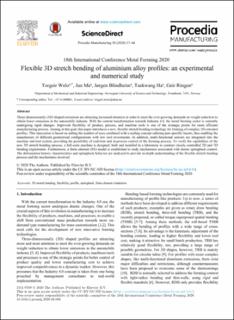| dc.contributor.author | Welo, Torgeir | |
| dc.contributor.author | Ma, Jun | |
| dc.contributor.author | Blindheim, Jørgen | |
| dc.contributor.author | Ha, Taekwang | |
| dc.contributor.author | Ringen, Geir | |
| dc.date.accessioned | 2020-09-25T07:23:24Z | |
| dc.date.available | 2020-09-25T07:23:24Z | |
| dc.date.created | 2020-09-13T15:41:01Z | |
| dc.date.issued | 2020 | |
| dc.identifier.citation | Procedia Manufacturing. 2020, 50 37-44. | en_US |
| dc.identifier.issn | 2351-9789 | |
| dc.identifier.uri | https://hdl.handle.net/11250/2679577 | |
| dc.description.abstract | Three-dimensionally (3D) shaped extrusions are attracting increased attention in order to meet the ever-growing demands on weight reduction to obtain lower emissions in the automobile industry. With the current transformation towards Industry 4.0, the metal forming sector is currently undergoing rapid changes. Improved flexibility of product, process, and machine tools is one of the strategic points for more efficient manufacturing process. Aiming at this goal, this paper introduces a new, flexible stretch bending technology for forming of complex 3D extruded profiles. This innovation is based on adding the number of axes combined with a tooling concept utilizing part-specific inserts, thus enabling the manufacture of different geometrical configurations with low tool investments. In addition, multi-functional sensors are integrated into the machine and tool system, providing the possibility of real-time and in-process control of the forming process. To verify the capabilities of the new 3D stretch bending process, a full-scale machine is designed, built and installed in a laboratory to conduct closely-controlled 2D and 3D bending experiments. Furthermore, a finite element (FE) model is established to study mechanisms associated with elastic springback control. The deformation history characteristics and springback behavior are analyzed to provide in-depth understanding of the flexible stretch bending process and the mechanisms involved. | en_US |
| dc.language.iso | eng | en_US |
| dc.publisher | Elsevier | en_US |
| dc.rights | Attribution-NonCommercial-NoDerivatives 4.0 Internasjonal | * |
| dc.rights.uri | http://creativecommons.org/licenses/by-nc-nd/4.0/deed.no | * |
| dc.title | Flexible 3D Stretch Bending of Aluminium Alloy Profiles: An Experimental and Numerical Study | en_US |
| dc.type | Peer reviewed | en_US |
| dc.type | Journal article | en_US |
| dc.description.version | publishedVersion | en_US |
| dc.source.pagenumber | 37-44 | en_US |
| dc.source.volume | 50 | en_US |
| dc.source.journal | Procedia Manufacturing | en_US |
| dc.identifier.doi | https://doi.org/10.1016/j.promfg.2020.08.008 | |
| dc.identifier.cristin | 1829445 | |
| dc.description.localcode | © 2020 The Authors. Published by Elsevier B.V. This is an open access article under the CC BY-NC-ND license (http://creativecommons.org/licenses/by-nc-nd/4.0/) | en_US |
| cristin.ispublished | true | |
| cristin.fulltext | original | |
| cristin.qualitycode | 1 | |

